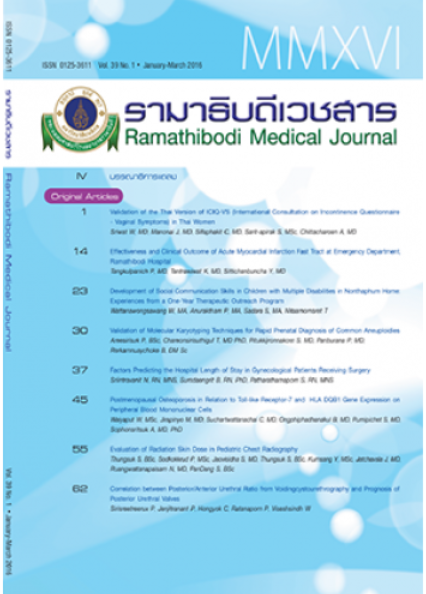Evaluation of Radiation Skin Dose in Pediatric Chest Radiography
Keywords:
Radiation dose, Pediatric, Chest radiographyAbstract
Objective: To evaluate quantity of the radiation dose to skin (entrance surface air Kerma (ESAK)) expose to children underwent anteroposterior (APZ) and posteroanterior (PA) chest radiography compared with the other reference values in order to make a proper parameter adjustment.
Material & Methods: Data was collected in chidren below 15 years old who underwent AP or PA chest radiography during one-month of studied period. The radiation dose to skin was calculated from the X-ray beam output and the parameters used in each patient and then compared with the reference values provided by the two institutes taking care of the radiation safety. the National Radiological Protection Board (NRPB) of England and the European Commission (EC). along with the previous studies.
Result: Total of 100 patients were included. Age groups were infants (<1 year). 1 -< 5.5 < 10 and 10 - 15 years. The average radiation skin dose was 70.53 microgray (µGy, 67.62 µGy and 70.15 µGy in the 4 age groups, respectively. The infants and children aged 1 -< 5 years received more radiation skin dose than the two older groups. Infants and children aged 1 - < 5 years received more radiation skin dose than the reference values of the NRPB but less than those of the EC. On the other hand, children aged 5 - < 10 and 10 - < 15 years received less ratiation skin dose than those of both the NRPB and EC. When compared with the previous studies in other countries: infants received more radiation skin dose whereas other older age groups did less.
Conclusion: The infants and children aged 1 - < 5 years received more radiation skin dose than the reference values provided by the NRPB and the EC. The infants also received more radiation skin dose than those in other countries when compared to previous studies. This result designates that the radiation technicians have to adjust parameters properly to reduce the radiation skin dose to the infants in particular, and in the children aged 1 - < 5 years old.
References
Hart D, Wall BF, Shrimpton PC, et al. Reference Doses and Patient Size in Paediatric Radiology. Chilton, UK; National Radiological Protection Board (NRPB) 2000: NRPB-R318.
Kohn MM, Moores BM, Schibilla H, et al. EUR 16261 - European Guidelines on Quality Criteria for Diagnostic Radiographic Images in Paediatrics Luxembourg. Office for Official Publications of the European Communities 1996.
Pernicka F, McLean ID. Dosimetry in Diagnostic Radiology: An International Code of Practice, Technical Reports Series N๐457, Austria, IAEA 2007, 23-155.
Atalabi OM, Akinlade B, Adekanmi AJ, et al. Entrance surface dose from pediatric diagnostic X-ray examinations is a developing world setting: Are we ‘ALARA principle’ compliant? Br J Medicine Med Res. 2013;3:2288-98.
Suliman ll, Elawed SO. Radiation dose measurements for optimisation of chest X-ray examinations of children in general radiography hospitals. Radiat Prot Dosimetry. 2013;156:310-4.
Azevedo ACP, Osibote OA, Boechat MCB. Paediatric X-ray examinations in Rio de Janeiro. Phys Med Biol. 2006;51:3723-32.
Downloads
How to Cite
Issue
Section
License
Copyright (c) 2016 By the authors. Licensee RMJ, Faculty of Medicine Ramathibodi Hospital, Mahidol University, Bangkok, Thailand

This work is licensed under a Creative Commons Attribution-NonCommercial-NoDerivatives 4.0 International License.













